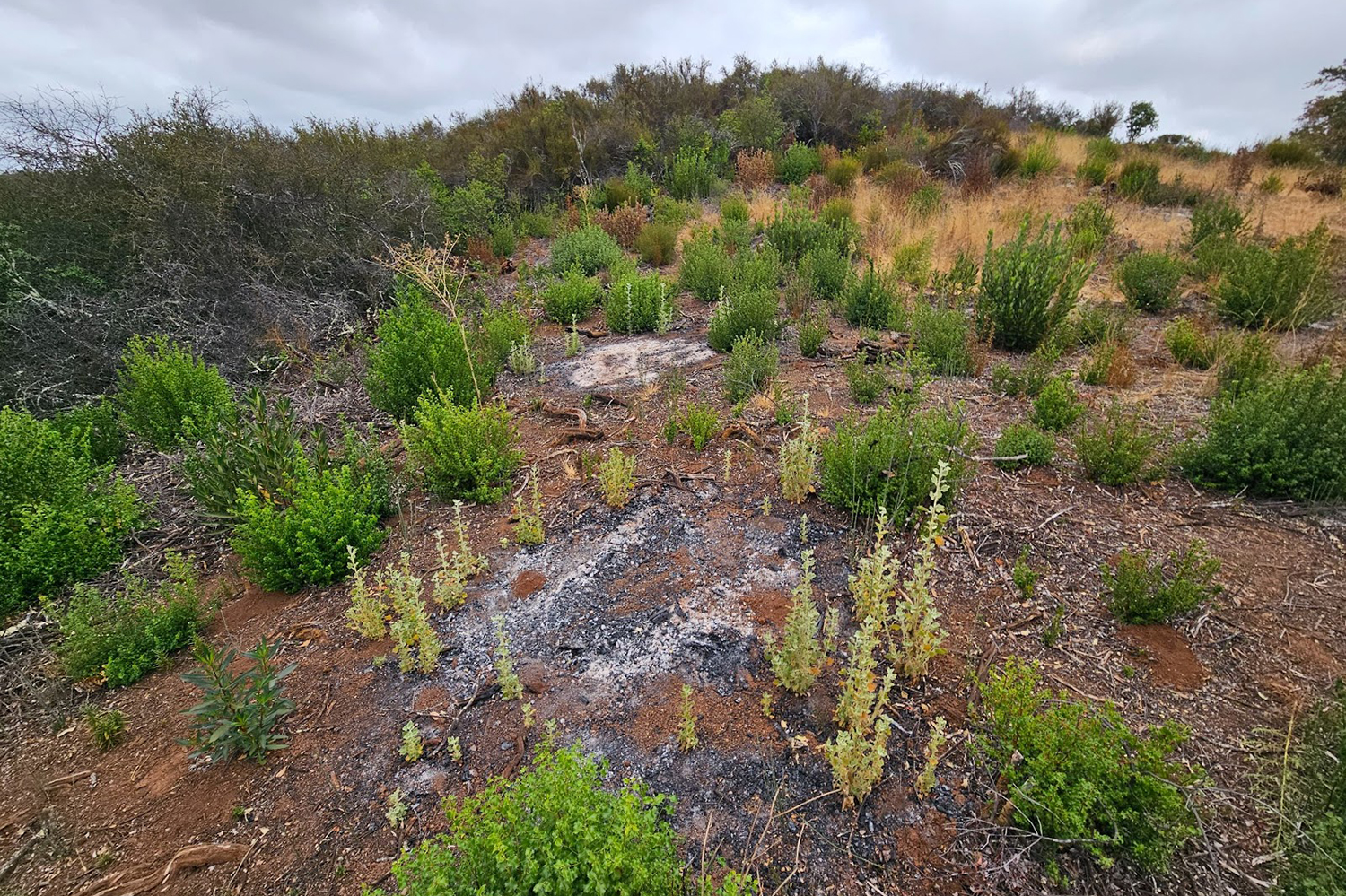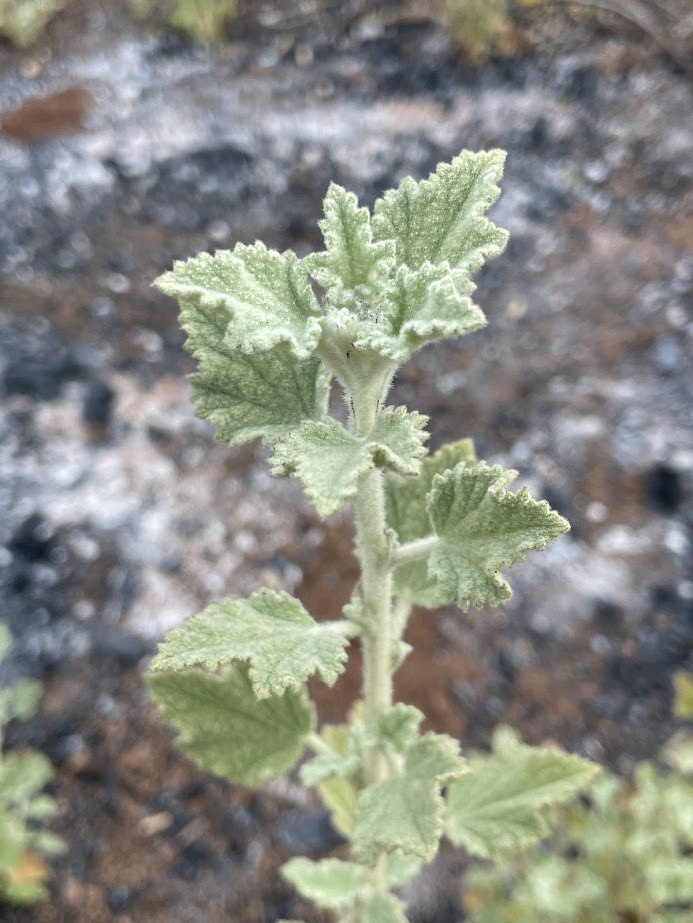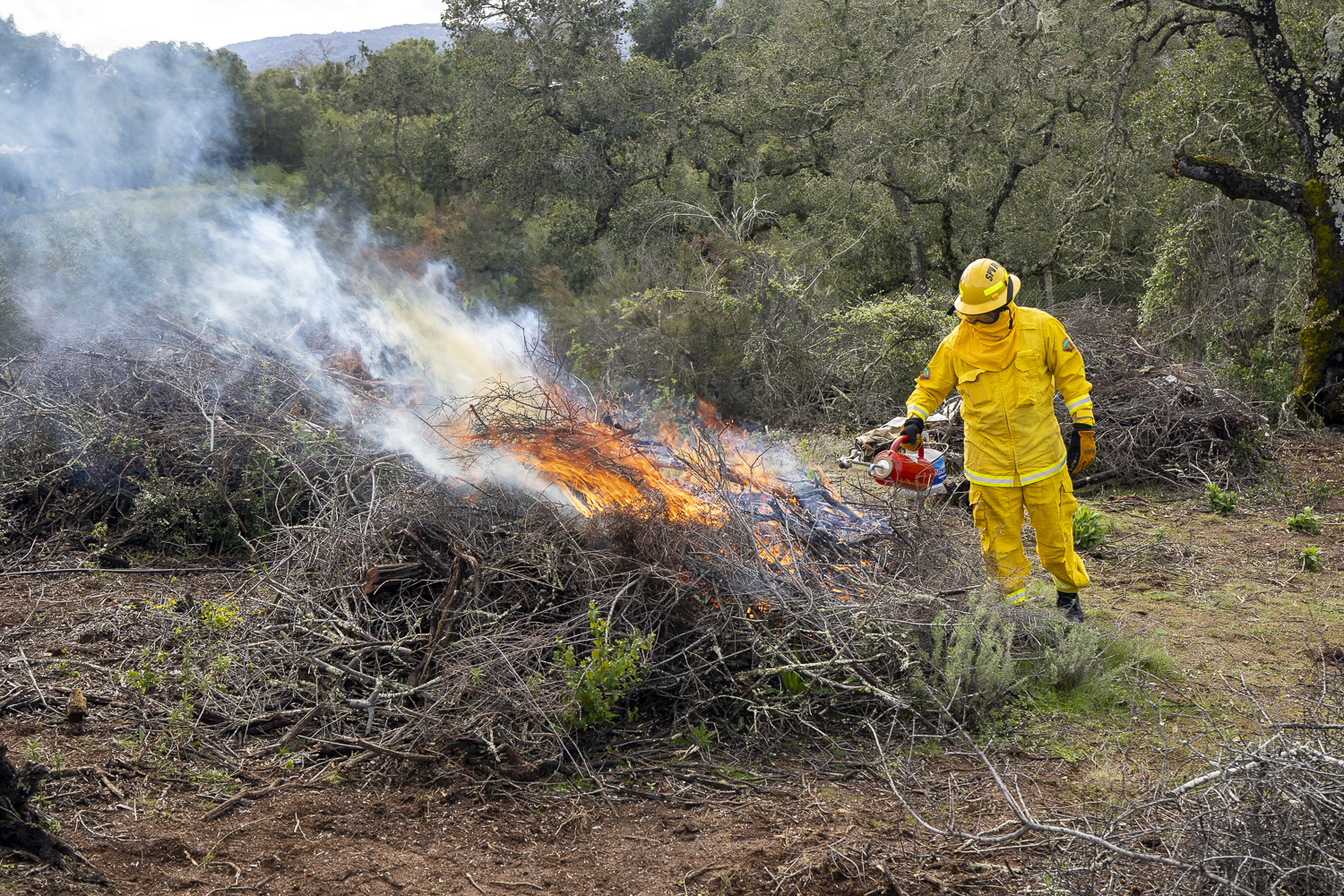In this essay, Tadashi Fukami, the faculty director of Jasper Ridge Biological Preserve, describes a rare, fire-dependent plant that likely germinated from the centuries-old seed bank in the burned soil.
Half a year has passed since intentional fires in the form of pile burns were used for the first time in the 50-year history of the Jasper Ridge Biological Preserve ('Ootchamin 'Ooyakma). Back in October 2023, nearly 200 piles of woody materials were made from clearing of the chaparral vegetation along the Westridge border of the preserve, orchestrated by the stewardship scientist, Sheena Sidhu. In March 2024, these piles were burned by a fire crew led by the burn boss, Phil Dye.
This burn was conducted as part of the university’s wildfire management plan, but the fire was given a deeper meaning by members of the Muwekma Ohlone Tribe of the San Francisco Bay Area. We were fortunate to have Chairwoman Charlene Nijmeh and other Tribal members come to guide us on the first day of the week-long burning in March. They taught the fire crew, the preserve staff, and the students and faculty who also came to see the burn the ecological significance of bringing back sacred fire to their ancestral homeland. The Tribal members also offered blessings and prayers in the Chochenyo language, giving the burn a spiritual meaning grounded on the Indigenous traditional wisdom, as featured in a Stanford Report article.

Western bewildering bushmallow plants growing around a burned pile. | Adriana Hernandez
Six months later, few plants have come back in the middle of the burned piles. Along the edge of the piles, however, we are witnessing a wave of new growth of fire-adapted chaparral plants in the burned area. Some of these were already abundant in the area before the fire, including yerba santa (Eriodictyon californicum), pitcher sage (Lepechinia calycina), and bluewitch nightshade (Solanum umbelliferum). But we are excited to also see an outburst of some rare plants that we didn’t see before the fire. One notable example is western bewildering bushmallow (Malacothamnus arcuatus var. arcuatus). This plant is endemic to the San Francisco Bay Area, meaning that it is found only here on the Ohlone land and nowhere else in the world. It is currently listed as "fairly threatened" by the California Rare Plant Ranks. The companion article by Adriana Hernandez provides more botanical details of this plant and its history at the preserve.
Despite its current status of being rare and threatened, many new plants of the bushmallow are growing vigorously around more than a dozen burned piles. Judging from where and how they have grown, these plants must have come from seeds that stayed dormant in the soil for a long time. Seeds of this plant can remain dormant for at least several decades, and they require fire to germinate. In a recent study, 13 of 15 seeds from an 88-year-old herbarium specimen germinated (Morse 2023). At this particular area in the preserve, they must have remained dormant for more than a century since fire had been suppressed that long here.

Western bewildering bushmallow growing at the edge of a burned pile | Tadashi Fukami
The fact that we see them growing only around the edge of burned piles, and not in the middle, suggests that fire was too intense in the middle, killing all seeds, whereas fire intensity was just right along the periphery of the piles. That is, whatever effect the burning had around the piles was weak enough for the seeds to survive the heat, ash, and smoke, but strong enough to stimulate their germination and growth. This gentle fire is perhaps similar to what was typical of Indigenous burning used to encourage plant growth, practiced here for hundreds of years before European contact (Anderson and Keeley 2018). Although the traditional use of western bewildering bushmallow by the local peoples is unclear, its close relative, chaparral mallow (Malacothamnus fasciculatus), is used by the Kumeyaay in southern California for various purposes – seeds as food, flowers as cordage, roots as medicine, and leaves as a hair rinse.
It seems fitting then to view the return of the endangered, locally endemic bushmallow as a symbol of Indigenous awakening. Michael Wilcox, a senior lecturer in Native American studies, teaches us that awakening is often a more appropriate word to use than revitalizing, a more commonly used expression, when we talk about cultural and language revitalization of an Indigenous group.
Here in the Bay Area, the Ohlone peoples and their cultures and languages have never gone extinct despite the devastating challenges they have suffered from over the last few centuries. Similarly, many local native plants like western bewildering bushmallow have not gone extinct despite the severe population decline they have likely experienced as a result of fire suppression and other environmental changes. When we restore local Indigenous culture, like gentle fires, they wake up from the long sleep in the seed bank.
In this context, the bushmallow gives us a glimpse of what is to come as we bring back the traditional reciprocal relationship between humans and the rest of the local flora and fauna with whom we share the land. With the Muwekma Ohlone Tribe’s effort toward reaffirmation of federal recognition going strong with the Trail of Truth protest, it seems inevitable that we will see a major awakening of the Native peoples of this land and their science, culture, and languages. The benefits this awakening will bring are profound, not just for the tribe, but for everyone living in the Bay Area, because the locally relevant, time-tested Indigenous wisdom is essential to achieving environmental sustainability for everyone (Nelson and Shilling 2018).
The bushmallow at the pile burn site reminds us of the power of two-eyed seeing (Bartlett et al. 2012), the multicultural approach to learning from and caring for the land. By recognizing that Indigenous and Western science can thrive together and complement each other in a climate of mutual respect, Jasper Ridge Biological Preserve looks forward to promoting more collaboration with Indigenous groups toward authentic two-eyed seeing for research, education, and stewardship.
For more information
Originally published by Jasper Ridge Biological Preserve.
